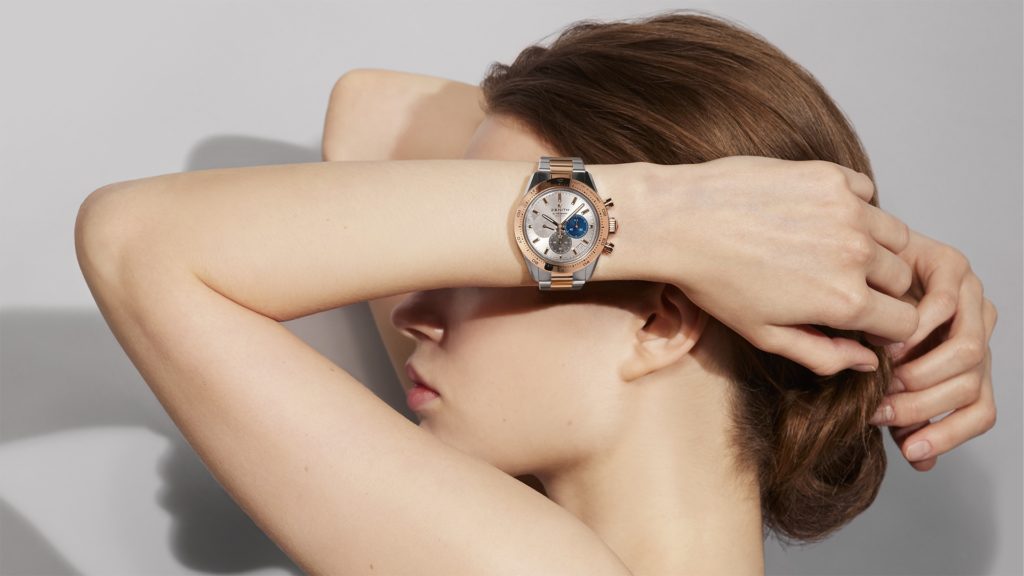In the watch world, the difference between 'for him' and 'for her' is slowly but surely being diluted. More and more brands are introducing gender-neutral watches. And the range is only getting prettier...
Text: Thomas van Straaten
Every now and then, as a society, we go through a period of change. A time when old assumptions and habits are tested and broken. This is usually accompanied by discomfort and resistance. Sometimes it results in a temporary setback or even reinforcement of the status quo. But almost always we end up in a better place.
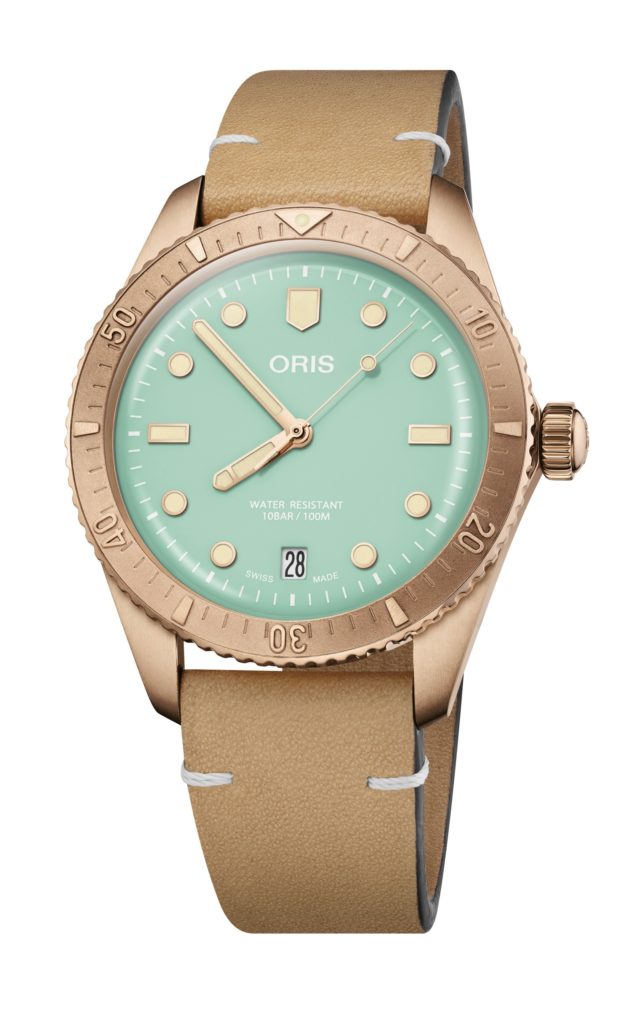
We are now in the midst of such a growth spurt. Across the Western world, there is a growing realisation that we do not treat each other as equally as we have long deluded ourselves. Our ancestors had abolished slavery, introduced passive and active women's suffrage, made the colonies independent and introduced all kinds of legislation to ensure equal treatment under equal conditions. Surely that was the end of the matter? Surely not.
"We build watches for the confident and independent people of today."
We increasingly realise that -even if we consider ourselves tolerant and open-minded- we harbour all kinds of unconscious prejudices and (often unintentionally) favour those who are most like ourselves. We are now experiencing the growing pains that come with critical self-reflection. At least, let's hope it's growing pains, because that implies progress.
In our own little world, that of watches, this development is also at play. In this article, we are going to take a critical look at one eye-catching example: gender-specific watches. And yes, we see the irony of this issue in a magazine that Gentlemen's Watch hot, but perhaps that is precisely why it is good to look at this with an open mind.
A men's line and a women's line, just like in fashion
The watch industry behaves in some ways similar to the fashion world. Working in collections, especially the rigid split of Ladies' and Men's collections, is very similar. Therefore, we are not at all surprised when a watch brand's collection is neatly divided into two: Ladies' and Men's.
But does that actually make sense? At least in the fashion world, you still have to deal with distinctly different body shapes and proportions that you have to take into account in product design. In this analogy, you could argue that women on average have a slightly thinner wrist than men, but apart from the length of the watch strap, this has hardly any implications for what a men's or a women's watch should be. You could already cover that with a 'short strap' and 'long strap' option.
Of course, in addition, you have differences in aesthetic preferences. A skirt is for women, trousers for men. But let's face it, those are fluid, time- and place-based norms. It doesn't take much more than a few influential examples to shift such norms. It already happened with trousers for women and is now going on, for example, with nail polish for men.
Of course, you will discover statistically relevant differences if you were to survey the tastes of male and female watch lovers on a large scale. The only question is: does that actually justify this split? Is this the most logical division?

Unnecessarily exclusive
We think not. Indeed, it is unnecessarily exclusive. After all, you are simultaneously saying "this is for you" to half the world and "this is not for you" to the other half. And why would you do that? Of course, there are the independent spirits who just don't care about this. Ladies who happily strap on a men's watch and men who don't hesitate to wear a ladies' watch. But it introduces an unnecessary inconvenience, or at least a barrier.
We can let go of those uncertainties with peace of mind, adding to the enjoyment of the hobby.
And then there is the fact that far from everyone recognises a binary split between men and women. Something we have long looked away from society-wide, but which is now increasingly recognised as a valid paradigm shift. That in itself could be reason enough to do things differently for a change.
Alternative layouts
You could perfectly well classify watches by style or occasion. A formal collection and an adventurous one, to name a few. Then you can search in a targeted way as a consumer, without being unnecessarily excluded. You also then no longer need to imply that women only like shiny, little quartz watches in bright colours, because that is both nonsensical and denigrating.
Nomos is a good example of this approach. The minimalist brand from Glashütte divides its collection into what they call 'Model families'. These are the different models, each of which is then available in different designs, sizes and colourways. Nothing or no one suggests that as a man I should choose a particular size, or that certain colours would only suit female wearers.
Now most brands do this, only they then add a male/female split as well. Unnecessary, as you'll notice when you peruse Nomos' crystal-clear collection.
We spoke to Nomos' Chief Brand Officer Judith Borowski: "We believe that people, both men and women, buy watches that suit them. And what suits someone is not just a matter of gender. Above all, it's about whether someone is sporty or likes to sit at their desk at home, whether they like steel or gold, whether they like business, understated, reserved or playful, striking or a bit more lavish and luxurious. (...) We don't push gender stereotypes in our marketing either; you won't find big cars, submarines or planes here. We build watches for today's confident and independent people."
When we ask Borowski how they implement this gender-neutral watch vision in day-to-day operations, she tells us that more women than men work at Nomos, despite the fact that it is estimated that some 70% of Nomos watches are bought by men. In addition, the company has long employed flexible working hours to best combine jobs with family life. So it is not just for show.
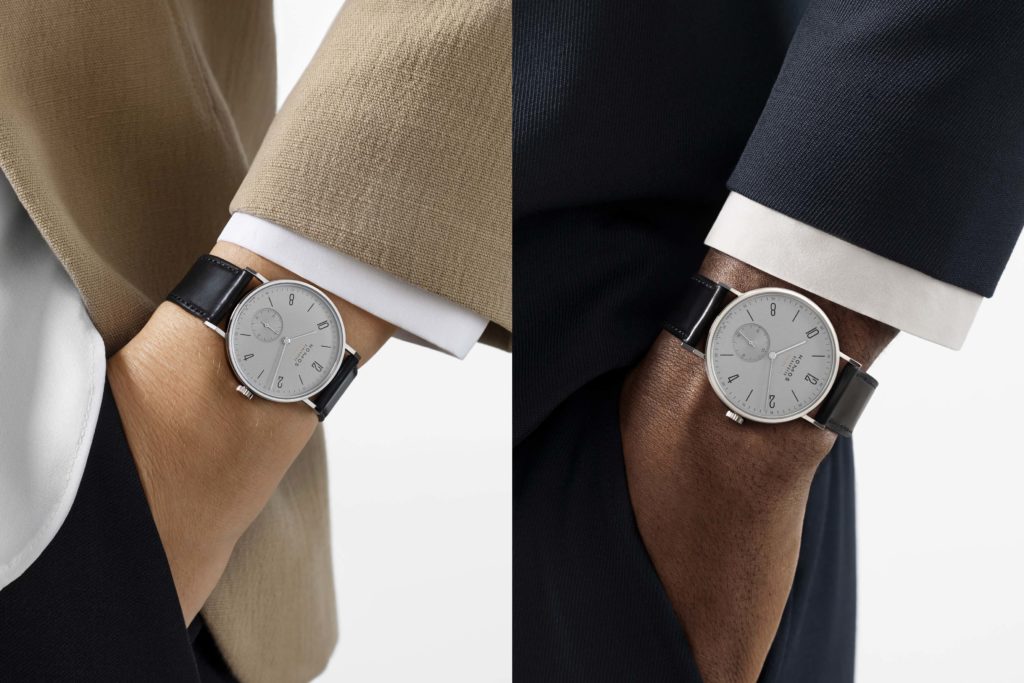
The question of size
As men among ourselves, wouldn't it be great if we could just pick a watch in a size we like and find comfortable, without a marketer in Switzerland telling us whether it makes us more masculine or more feminine? That we then agree among ourselves that we simply no longer link size to masculinity at all? A relief right?
In the fashion world, you have different body shapes to consider.
A 36mm and a 41mm version of the same watch have a totally different visual effect on the wrist. Regardless of the size of that wrist. That's a style choice you make based on your own taste. To hang notions of masculinity on that is madness. Your grandfather would laugh hard at it too, with his 32 mm watch. It is mostly an idea inspired by the oversized watch trend from around 2000 to 2015. We can let go of those uncertainties with confidence, potentially adding to the enjoyment of the hobby.
Incidentally, it is natural for people with smaller wrists to tend towards smaller watches. And it is true that women on average have a narrower wrist than men. However, the variation within both groups is so great that men's larger wrists on average are not a valid reason to designate a smaller variant as a women's model and a larger variant as a men's model.
Lifestyle branding
Now Nomos maintains a serene, hushed style when it comes to branding. This suits the brand, with its modern, minimalist look. No lifestyle images of racing drivers, commandos, or gorgeous famous actresses in gala dresses here. At Nomos, it's all about the product. We see lots of white and free-cut details of watches, combined with text. Of course, this makes gender-neutral positioning a lot easier.
Zenith partly chooses a more difficult route in that respect, but successfully. Part of the collection is presented on the website in the same style as Nomos, focusing only on the product. The entire Elite collection, for example, is shown neutrally. Whatever variant you click on, big or small, with or without diamonds, with or without bright colours, is described based on what the watch is and what feeling it evokes. And the 'male' Chronomaster collection shows mostly female arms, perhaps due to the fact that women buy men's watches more easily than the other way around.
Also significant is a 2019 ad campaign that showed Zenith's biggest and toughest watches on female models. Thus, a woman can be seen with the oversized Zenith Pilot Type 20 on her wrist. A clear statement that these watches are not exclusive to him or her. Tag Heuer, which is under the same LVMH group as Zenith, does still work with a wider male/female split in its collection. So Zenith has clearly been given a leading role within the family.
Sole ornament
Of course Tag Heuer a brand that operates on a totally different scale from the aforementioned Nomos. The budgets for, say, market research are correspondingly different. This leads to perhaps a less idealistic, and more data-driven approach to gender. General Manager Tag Heuer Central Europe Davide Lunghi: "Obviously, men and women approach the purchase of a watch differently. For men, it is the only legitimate piece of jewellery, where for women it is more of an accessory to go with their outfit and other fashion pieces. Men are strongly influenced by design, materials and technology, the timepieces and connections with ambassadors and partner brands, such as Porsche and Red Bull Racing, and history. Women tend to be more emotional and focus on visual elements of a watch, such as colours, precious materials like gold or diamonds, or other fashionable aspects."
Also at Tag Heuer, some 70% of watches are sold to men. Lunghi does stress that they clearly see that more and more women are also opting for watches that are fundamentally more male-oriented.
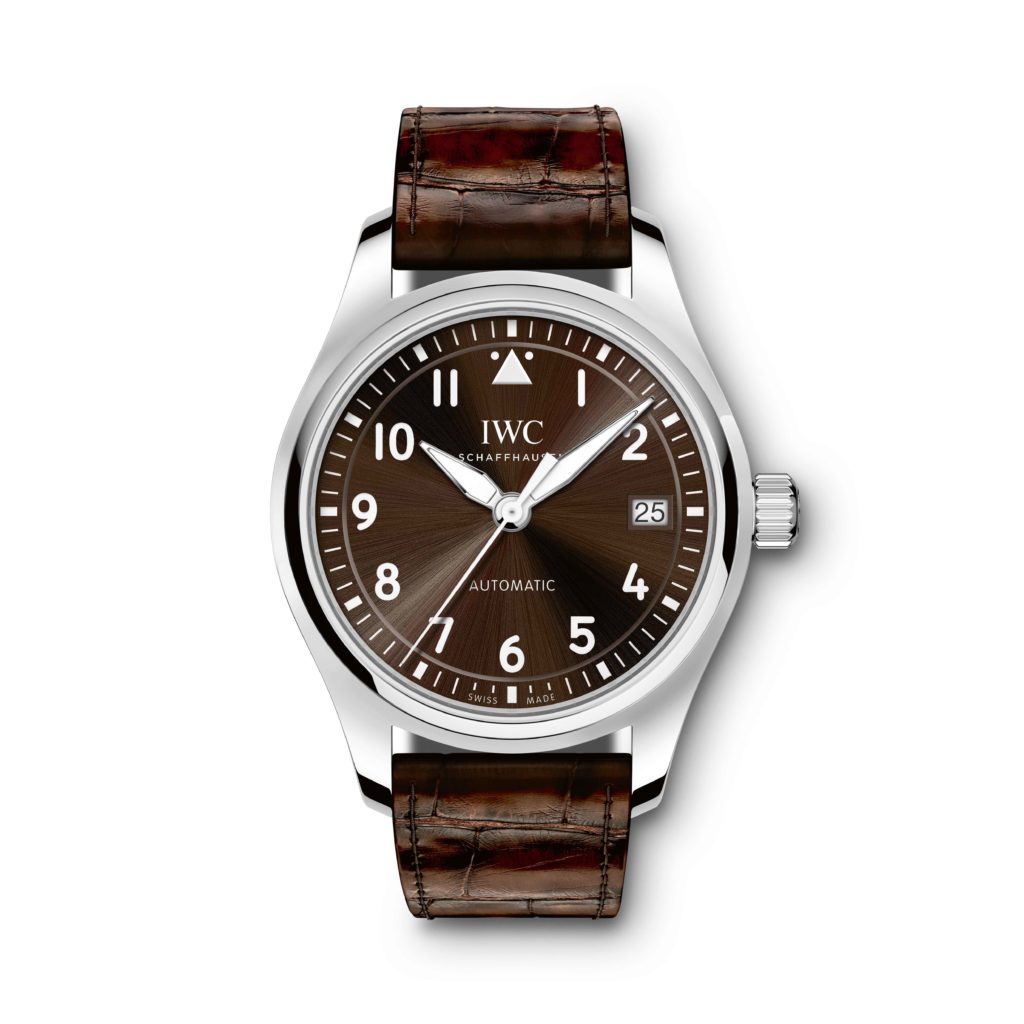
The way forward
Still, when we ask Lunghi about the future, we see more of a Nomos-like philosophy: "I think the so-called gender-designation of different watches will become less and less. That soon we will only talk about watches in different sizes. Something we are already doing with our new models."
You don't have to be outspoken woke to see that the watch world is better off without gender-divide. At the same time, there is no point in being overly harsh and ideological about it. It is, after all, a norm that has evolved over decades, without anyone ever having had ill intentions towards it. Anno 2022, however, it has lost its utility and the advantages no longer outweigh the disadvantages.
To hang notions of masculinity on that is madness.
We can therefore clearly see watch brands pre-sorting for a new approach. Some have already completely jettisoned the male/female split, while others are still building on two completely separate collections for him and her. Most are shifting more cautiously within the spectrum, looking for the right position. Any major movement in any direction is met with much criticism by fanatics on both sides, which makes brands cautious. But the movement has overwhelmingly started and the only question that remains is: how far will it eventually be implemented and how long will it take to get there?
